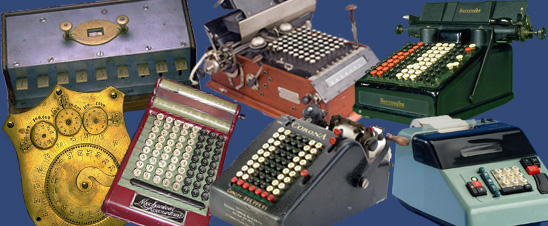From the mid-19th century, a few adding machines were built with an array of nine or ten keys for entering digits. The clockmaker Jean-Baptiste Schwilgué patented such a machine in France in 1844. Schilt had worked for Schwilgué before building his machine. He showed the instrument at the Crystal Palace exhibit, a World’s Fair held in London in 1851. Schilt declined to make copies of this machine, and had little immediate influence on the design of adding machines. In the course of the 19th century, inventors like David Carroll of Pennsylvania and the French-born priest Michael Bouchet of Louisville, Kentucky, also proposed adding machines with a limited number of keys. Bouchet seems to have found a handful of customers. Ten-key adding machines devised by rabbi Judah Levin of Detroit and Frank S. Baldwin of New Jersey also found no wide market.
During the 1890s, Albert C. Ludlum of Brooklyn and then Denver, and William W. Hopkins of St. Louis took out patents for a ten-key adding machine that would print results. From 1903 it was manufactured in St. Louis as the Standard adding machine. The Standard was, the first widely distributed ten-key adding machine on which the numbers printed were visible.
The success of the Standard inspired imitators. Inventors at Burroughs Adding Machine Company designed a ten-key adding machine, although it was not marketed. Sydney B. Austin of Baltimore prepared a similar machine. William Hopkins’s younger brother, machinist Hubert Hopkins, patented his own version of a ten-key adding machine. After complex business dealings, including intervention from other adding machine manufacturers, James L. Dalton acquired exclusive rights to manufacture machines under the Hopkins patents. From 1903, a firm soon known as the Dalton Adding Machine Company made the machine in Missouri and then Ohio, until it was acquired by Remington Rand in 1927. Remington Rand would also acquire rights to a lighter ten-key machine, built on patents of Thomas Mehan and originally sold as the Brennan.
Slightly later than Hopkins, Osker Sundstrand of Illinois introduced an adding machine that featured digit keys arranged in a 3 x 3, with a zero bar underneath. This became standard, and would be used not only on adding machines, but on later electronic calculators. In 1926, the Sundstrand Adding Machine Company was acquired by Elliott Fisher, a firm known for its bookkeeping machines. This company, in turn, merged with the Underwood Typewriter Company, which sold the Underwood Sundstrand adding machine for many years. The Italian firm of Olivetti purchased a controlling share of Underwood Corporation in 1959, and soon placed a redesigned ten-key adding machine on the market.
By the mid-20th century, ten-key adding machines took a growing share of the market. Victor Adding Machine Company of Chicago, which had initially sold full-keyboard machines, introduced a ten-key machine in 1939. After World War II, Victor would acquire one of the first manufacturers of full-keyboard machines, Felt & Tarrant. The venerable Burroughs Adding Machine Company also introduced a ten-key machine, patterned on the British Summit. A few ten-key machines were imported from Europe and Japan. Plastic machines with fewer keys and limited capabilities were made in Japan and Hong Kong.
